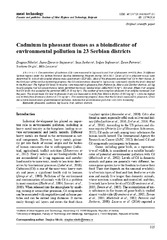Cadmium in pheasant tissues as a bioindicator of environmental pollution in 23 Serbian districts
2016
Аутори
Nikolić, DragicaĐinović-Stojanović, Jasna
Janković, Saša
Stefanović, Srđan
Petrović, Zoran
Grujić, Svetlana

Laušević, Mila
Чланак у часопису (Објављена верзија)
Метаподаци
Приказ свих података о документуАпстракт
Concentrations of cadmium (Cd) were measured in leg muscle and liver of pheasants (n=316) from 23 different Serbian regions under the Serbian National Residue Monitoring Program during 2013-2015. Levels of Cd in pheasant tissues were determined by inductively-coupled plasma mass spectrometry (ICP-MS). Most of the pheasants examined had Cd in their tissues. In the third year of the residue monitoring program, the Cd concentrations detected in leg muscles were nearly double the levels detected in the first year. The highest Cd levels in muscles were measured in pheasants from Podunavlje, Macva and Zlatibor districts. All leg muscle samples had Cd concentrations below permitted maximum residue levels (MRL=0.05 m kg-1). However, fifteen liver samples had Cd levels that exceeded the permitted MRL (0.50 mg kg-1). The number of non-compliant pheasant liver samples increased over the years. The lowest mean Cd level in pheasant livers was measured in birds from Morava district (0.035 mg kg-1), w...hile the highest was in birds from Branicevo district (0.574 mg kg-1). This monitoring program shows that the Cd levels measured in pheasants, which are suitable bioindicators of environmental pollution, indicate that environmental pollution with Cd is increasing.
Кључне речи:
pheasants / cadmium / leg muscle / liver / Serbian districtsИзвор:
Meat technology, 2016, 57, 2, 115-119Издавач:
- Institute of meat hygiene and technology
Финансирање / пројекти:
- Унапређење и развој хигијенских и технолошких поступака у производњи намирница животињског порекла у циљу добијања квалитетних и безбедних производа конкурентних на светском тржишту (RS-MESTD-Integrated and Interdisciplinary Research (IIR or III)-46009)
Институција/група
Tehnološko-metalurški fakultetTY - JOUR AU - Nikolić, Dragica AU - Đinović-Stojanović, Jasna AU - Janković, Saša AU - Stefanović, Srđan AU - Petrović, Zoran AU - Grujić, Svetlana AU - Laušević, Mila PY - 2016 UR - http://TechnoRep.tmf.bg.ac.rs/handle/123456789/3195 AB - Concentrations of cadmium (Cd) were measured in leg muscle and liver of pheasants (n=316) from 23 different Serbian regions under the Serbian National Residue Monitoring Program during 2013-2015. Levels of Cd in pheasant tissues were determined by inductively-coupled plasma mass spectrometry (ICP-MS). Most of the pheasants examined had Cd in their tissues. In the third year of the residue monitoring program, the Cd concentrations detected in leg muscles were nearly double the levels detected in the first year. The highest Cd levels in muscles were measured in pheasants from Podunavlje, Macva and Zlatibor districts. All leg muscle samples had Cd concentrations below permitted maximum residue levels (MRL=0.05 m kg-1). However, fifteen liver samples had Cd levels that exceeded the permitted MRL (0.50 mg kg-1). The number of non-compliant pheasant liver samples increased over the years. The lowest mean Cd level in pheasant livers was measured in birds from Morava district (0.035 mg kg-1), while the highest was in birds from Branicevo district (0.574 mg kg-1). This monitoring program shows that the Cd levels measured in pheasants, which are suitable bioindicators of environmental pollution, indicate that environmental pollution with Cd is increasing. PB - Institute of meat hygiene and technology T2 - Meat technology T1 - Cadmium in pheasant tissues as a bioindicator of environmental pollution in 23 Serbian districts EP - 119 IS - 2 SP - 115 VL - 57 UR - https://hdl.handle.net/21.15107/rcub_technorep_3195 ER -
@article{
author = "Nikolić, Dragica and Đinović-Stojanović, Jasna and Janković, Saša and Stefanović, Srđan and Petrović, Zoran and Grujić, Svetlana and Laušević, Mila",
year = "2016",
abstract = "Concentrations of cadmium (Cd) were measured in leg muscle and liver of pheasants (n=316) from 23 different Serbian regions under the Serbian National Residue Monitoring Program during 2013-2015. Levels of Cd in pheasant tissues were determined by inductively-coupled plasma mass spectrometry (ICP-MS). Most of the pheasants examined had Cd in their tissues. In the third year of the residue monitoring program, the Cd concentrations detected in leg muscles were nearly double the levels detected in the first year. The highest Cd levels in muscles were measured in pheasants from Podunavlje, Macva and Zlatibor districts. All leg muscle samples had Cd concentrations below permitted maximum residue levels (MRL=0.05 m kg-1). However, fifteen liver samples had Cd levels that exceeded the permitted MRL (0.50 mg kg-1). The number of non-compliant pheasant liver samples increased over the years. The lowest mean Cd level in pheasant livers was measured in birds from Morava district (0.035 mg kg-1), while the highest was in birds from Branicevo district (0.574 mg kg-1). This monitoring program shows that the Cd levels measured in pheasants, which are suitable bioindicators of environmental pollution, indicate that environmental pollution with Cd is increasing.",
publisher = "Institute of meat hygiene and technology",
journal = "Meat technology",
title = "Cadmium in pheasant tissues as a bioindicator of environmental pollution in 23 Serbian districts",
pages = "119-115",
number = "2",
volume = "57",
url = "https://hdl.handle.net/21.15107/rcub_technorep_3195"
}
Nikolić, D., Đinović-Stojanović, J., Janković, S., Stefanović, S., Petrović, Z., Grujić, S.,& Laušević, M.. (2016). Cadmium in pheasant tissues as a bioindicator of environmental pollution in 23 Serbian districts. in Meat technology Institute of meat hygiene and technology., 57(2), 115-119. https://hdl.handle.net/21.15107/rcub_technorep_3195
Nikolić D, Đinović-Stojanović J, Janković S, Stefanović S, Petrović Z, Grujić S, Laušević M. Cadmium in pheasant tissues as a bioindicator of environmental pollution in 23 Serbian districts. in Meat technology. 2016;57(2):115-119. https://hdl.handle.net/21.15107/rcub_technorep_3195 .
Nikolić, Dragica, Đinović-Stojanović, Jasna, Janković, Saša, Stefanović, Srđan, Petrović, Zoran, Grujić, Svetlana, Laušević, Mila, "Cadmium in pheasant tissues as a bioindicator of environmental pollution in 23 Serbian districts" in Meat technology, 57, no. 2 (2016):115-119, https://hdl.handle.net/21.15107/rcub_technorep_3195 .


